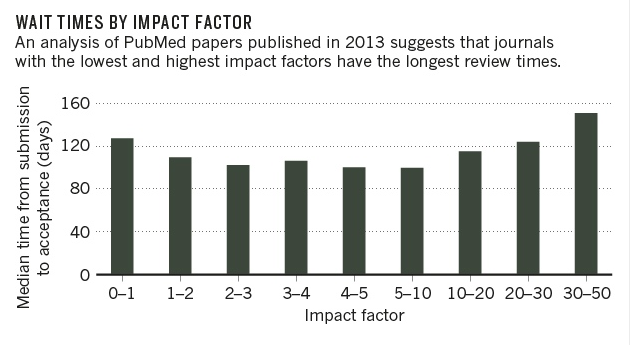Chasing the impact factor: Is it worth the hassle?

The usefulness of the journal impact factor (JIF) continues to be a contentious topic. Last month, a group of academics and editors at popular journals wrote an article (Lariviere, Vincent, et al. "A simple proposal for the publication of journal citation distributions" bioRxiv 2016: 062109) detailing why the JIF is not a useful measure of any article’s individual impact. Unfortunately, academia is deeply rooted in tradition, and for a long time the major currency among academics has been publication impact, as defined by the JIF. Further, “high impact” journals like Nature and Science seem to have a disproportionately high value for authors, due to their high JIF.
In this post, I’d like to talk about the excessive focus on the JIF and question whether these journals deserve to be valued so highly and if they are truly worth the costs associated with publishing in them.
The costs of publishing in a high impact factor journal are large. Costs, here, include the large time investments researchers have to make. It can take a long time to produce sufficient results to even get past the initial review by the editor. It has gotten to the point where a single article in a high impact factor journal is actually just a large number of individual results strung together to tell a “single” story. This is self-evident in the enormous size of the Supplementary Information Section in most high impact factor journals.
Also, the review process in these journals is usually very long, with reviewers feeling obliged to make the authors do more work to prove the 'impact' and 'importance,' which is often very time consuming for the author. Often, multiple rounds of reviews and revisions are required, which increases the time taken to publish. A recent study has reported a rough correlation between the impact factor and the time between submission and publication.

Image source: http://www.nature.com/news/does-it-take-too-long-to-publish-research-1.19320
In the figure above, the long times to publish for low impact factor journals may be due to the fact that there is now a large number of such journals that may not have the resources and systems in place to get reviews to authors quickly. The delays in publishing at the high impact factor journals could be due to higher expectations from reviews or higher volume of revision requests from reviewers.
So is the impact-factor chase worth the effort for authors? Let’s look at some of the benefits:
1. Prestige/Perceived value: The perceived benefit of publishing in a high profile journal is high. It is well known that a researcher needs to go through a lot of pain to get published in a journal like Science, Nature, or Cell, so simply accomplishing this carries high value. This value is entirely independent of the true citation count that the article would end up getting, of course.
2. Citation value: A major marketing benefit of “high impact” journals is that they have a high impact factor. This simply means that the average number of citations per year for articles in these journals is high. However, this does not imply that every article published in these journals will be cited. In fact, citation patterns of prestigious journals tend to be skewed, with few articles getting cited a lot and most articles getting cited very little, as Lariviere, V. et al have reported in their article. In Nature for example, the average number of citations for an article is 121 (over its life, till date). However, the median is 24 citations, and over 40% of articles are cited less than 10 times!*
3. Publicity value: Another major marketing advantage is that traditional and other mass media look to “high impact” journals to publish attractive articles about cool, new science. Several of these journals are not field specific, which means that they cater to a wide readership; additionally, the language used is such that most of the articles are comprehensible by any good scientist. Often, such journals also feature a News and/or Views section, where current or trending topics in scientific research are discussed or reported; typically, the general reader finds these sections easy to understand and other media agencies, such as BBC or CNN, also report them.
So how can scientists reap the benefits without the costs of a high impact factor journal?
Now that we have a fairly strong understanding of the various benefits a researcher obtains through publication in a high impact factor journal, we can elicit an important insight, that all of the benefits a high impact factor journal provides are on the marketing side of the paper. Therefore, logically speaking, if you can figure out strategies to market your paper using other channels, you don’t need to depend on high-impact journals for the marketing benefits!
One aspect of the marketing value is ‘brand’ awareness, via the reputation value of high impact factor journals such as Nature or Science, for example. While branding yourself is difficult, it is achievable thanks to social media these days. Some faculty are already in on the game and are very active on social media.
The other benefits outlined above all boil down to a single insight, that high impact factor journals push articles to more eyes. It is pretty clear given the citation analysis above that your article must provide some substantive value for people to cite it. However, just writing a quality article is not enough for it to gain a good number of citations. In addition, you will also have to make sure that your article is read by others by ensuring maximum discoverability. Thankfully, publishing in a prestigious journal is not the only way to give your article a wide readership.
Here are some other channels through which you yourself can promote your article and give it maximum visibility:
1. Social media: Use Twitter, Facebook and LinkedIn to promote your research. Your network and beyond will potentially read your work if you self-promote effectively.
2. Blogs: Write a lay version of your article, i.e., your own ‘news and views’ so that it can be easily understood by non-scientists on a personal blog to make your research accessible by a large audience.
3. News agencies: Contact your university newspaper/magazine and have them report on your findings. If your study is interesting enough, it might be reported it in mainstream newspapers.
4. Direct e-mails to colleagues: You can directly e-mail people in your field about your new work asking for their perspective/thoughts. That will definitely increase the number of people reading your work.
So let’s return to the original question: is publishing in high impact factor journals worth the hassle? It seems to me that the value these journals provide can be replaced with lower cost alternatives. In fact, not only can scientists avoid the pain of trying to publish in these journals, they can do better by influencing directly the visibility and access to their work. The cherry that tops it off is that all of the content and marketing work they put in is owned by them and remains an asset of the scientist as opposed to that of the journal. I am excited to see more and more scientists take ownership of their work, and build a stronger scientific ecosystem!
* This data was generated by the author using Thomson Reuters’ Web of Science tools
Note: This post is part of the Researcher Voice series, where guest authors share their views and experiences on various issues related to academic publishing. We invite and encourage you to comment with your own views. This post was originally published on LinkedIn. It has been republished on Editage Insights with some modifications and with the author’s approval.
Published on: Aug 29, 2016
Comments
You're looking to give wings to your academic career and publication journey. We like that!
Why don't we give you complete access! Create a free account and get unlimited access to all resources & a vibrant researcher community.














